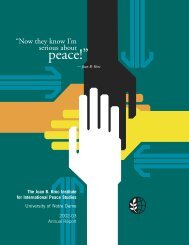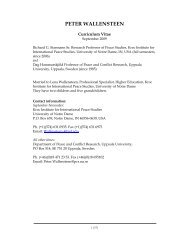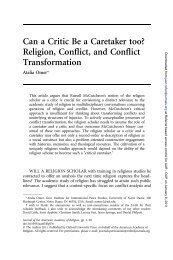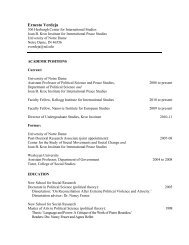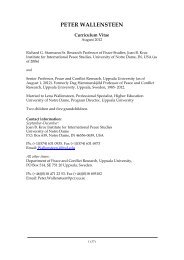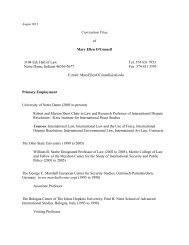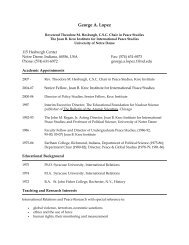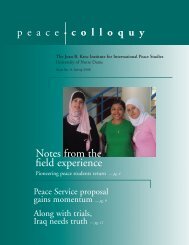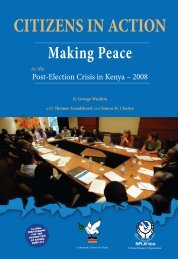Somalia: Creating Space for Fresh Approaches to Peacebuilding
Somalia: Creating Space for Fresh Approaches to Peacebuilding
Somalia: Creating Space for Fresh Approaches to Peacebuilding
You also want an ePaper? Increase the reach of your titles
YUMPU automatically turns print PDFs into web optimized ePapers that Google loves.
jessica brandwein<br />
22 See ““You Don’t Know Who To<br />
Blame”: War Crimes in <strong>Somalia</strong>”,<br />
Human Rights Watch, August<br />
2011, Available online <br />
23 Note that there are many<br />
purposes <strong>for</strong> framing an issue in a<br />
particular way, with the preference<br />
<strong>for</strong> peace journalism reflecting<br />
one vision of the media’s purpose<br />
– that is <strong>to</strong> aid in peacebuilding<br />
activities. Media consumers<br />
have different expectations <strong>for</strong><br />
how their news is presented<br />
based on their understanding<br />
of the purpose of the outlet. For<br />
those consumers who do expect<br />
media <strong>to</strong> play a substantive and<br />
responsible role in peacebulding,<br />
the use of peace journalism is one<br />
way in which this can be achieved.<br />
58<br />
so in the context of terrorism or al-Qaeda supporters. 35 percent of articles from<br />
allAfrica.com sources also frame al-Shabaab in the same way. When African<br />
news outlets are not relating al-Shabaab <strong>to</strong> terrorism, they are generally focused<br />
on the group’s participation in battles, its human rights violations, and its Islamic<br />
fundamentalist ideology. This depiction of al-Shabaab as an extremist enemy<br />
rather than a potential partner <strong>for</strong> engagement in peace limits the world’s view of<br />
how peacebuilding should be taking place in <strong>Somalia</strong>. Specifically, this framing<br />
rein<strong>for</strong>ces policies of non-engagement, making local peacebuilding ef<strong>for</strong>ts that<br />
attempt <strong>to</strong> bring al-Shabaab <strong>to</strong>gether with other groups more difficult. Additionally,<br />
the castigation of al-Shabaab masks the wrong doing of other ac<strong>to</strong>rs who are<br />
contributing <strong>to</strong> the suffering of the people and whose actions also undermine the<br />
prospects <strong>for</strong> peace. 22<br />
Peace journalism also emphasizes opportunities <strong>for</strong> peace as opposed <strong>to</strong> solely<br />
focusing on consequences of violence. It is clear <strong>to</strong> see from the framing results<br />
on peace that the NYT fails in this aspect of peace journalism, being nearly three<br />
times as likely <strong>to</strong> talk about civil wars or humanitarian crises than peace processes,<br />
and almost eight times more likely <strong>to</strong> refer <strong>to</strong> terrorism. 23 AllAfrica.com is<br />
more successful in this avenue, referring <strong>to</strong> peace processes more often than civil<br />
war, and almost as often as humanitarian crises or terrorism. However, because<br />
of the methods used <strong>to</strong> gather this data, it is impossible <strong>to</strong> know whether the<br />
articles were referring <strong>to</strong> peace processes in a positive or negative way. In order <strong>to</strong><br />
really understand whether the African sources are promoting peace through their<br />
journalism, or contributing <strong>to</strong> the pessimistic view of <strong>Somalia</strong> by focusing on the<br />
negative aspects of peace processes, further research needs <strong>to</strong> be done.<br />
Further research and recommendations<br />
While this paper has provided a broad description of the different ways in which<br />
<strong>Somalia</strong> has been portrayed by the African and Western press, in order <strong>to</strong> determine<br />
the actual effects the media has had on local and international peacebuilding<br />
more research must be completed. This includes the reading of articles <strong>to</strong><br />
determine <strong>to</strong>ne and orientation in addition <strong>to</strong> mere key word searches. At the<br />
least however, with the data available, it is clear that the Western media as represented<br />
by the coverage in the NYT has con<strong>for</strong>med <strong>to</strong> the US government’s view<br />
of <strong>Somalia</strong> as a safe haven and breeding ground <strong>for</strong> terrorists that serves as a<br />
threat <strong>to</strong> the national security of Western states. By framing <strong>Somalia</strong>, and particularly<br />
al-Shabaab within the broader context of terrorism, the NYT has supported<br />
and legitimized US policies of military intervention in <strong>Somalia</strong>, while justifying<br />
the lack of meaningful engagement in the country with peacebuilding issues.<br />
The rein<strong>for</strong>cement of this frame by the African media, as represented by<br />
allAfrica.com’s sources, and particularly in their one-sided portrayal of al-Shabaab,<br />
provides no alternative narrative that supports local peacebuilders trying <strong>to</strong> engage<br />
with the insurgent group. In order <strong>to</strong> change this pattern, the blind spot in media<br />
coverage of local and community led peacebuilding ef<strong>for</strong>ts, along with the positive<br />
contributions that al-Shabaab made <strong>to</strong> society within Southern <strong>Somalia</strong> need <strong>to</strong>



